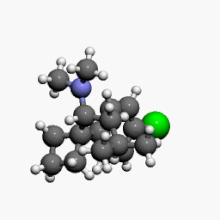Sibutramin
Sibutramin je organsko jedinjenje, koje sadrži 17 atoma ugljenika i ima molekulsku masu od 279,848 Da.[1][2][3][4][5][6]
 | |
 | |
| Klinički podaci | |
|---|---|
| Prodajno ime | Butramin, Medaria, Meridia, Reductil |
| Drugs.com | Monografija |
| Način primene | Oralno |
| Farmakokinetički podaci | |
| Poluvreme eliminacije | 1,1 h |
| Identifikatori | |
| CAS broj | 106650-56-0 |
| ATC kod | A08AA10 (WHO) |
| PubChem | CID 5210 |
| IUPHAR/BPS | 2586 |
| DrugBank | DB01105 |
| ChemSpider | 5021 |
| KEGG | C07247 |
| ChEMBL | CHEMBL1419 |
| Hemijski podaci | |
| Formula | C17H26ClN |
| Molarna masa | 279,848 |
| |
| |
| Fizički podaci | |
| Tačka topljenja | 191—192 °C (376—378 °F) |
Osobine
уреди| Osobina | Vrednost |
|---|---|
| Broj akceptora vodonika | 1 |
| Broj donora vodonika | 0 |
| Broj rotacionih veza | 5 |
| Particioni koeficijent[7] (ALogP) | 5,2 |
| Rastvorljivost[8] (logS, log(mol/L)) | -5,6 |
| Polarna površina[9] (PSA, Å2) | 3,2 |
Reference
уреди- ^ Sharma, B.; Henderson, D. C. (август 2008). „Sibutramine: Current status as an anti-obesity drug and its future perspectives”. Expert Opinion on Pharmacotherapy. 9 (12): 2161—73. PMID 18671470. S2CID 71049588. doi:10.1517/14656566.9.12.2161.
- ^ Tziomalos, K.; Krassas, G. E.; Tzotzas, T. (2009). „The use of sibutramine in the management of obesity and related disorders: An update”. Vascular Health and Risk Management. 5 (1): 441—52. PMC 2686261 . PMID 19475780. doi:10.2147/vhrm.s4027.
- ^ Heal, D. J.; Aspley, S.; Prow, M. R.; Jackson, H. C.; Martin, K. F.; Cheetham, S. C. (1998). „Sibutramine: A novel anti-obesity drug. A review of the pharmacological evidence to differentiate it from d-amphetamine and d-fenfluramine”. International Journal of Obesity and Related Metabolic Disorders : Journal of the International Association for the Study of Obesity. 22 Suppl 1: S18—28; discussion S29. PMID 9758240.
- ^ Stock, M. J. (1997). „Sibutramine: A review of the pharmacology of a novel anti-obesity agent”. International Journal of Obesity and Related Metabolic Disorders : Journal of the International Association for the Study of Obesity. 21 Suppl 1: S25—9. PMID 9130038.
- ^ Knox C, Law V, Jewison T, Liu P, Ly S, Frolkis A, Pon A, Banco K, Mak C, Neveu V, Djoumbou Y, Eisner R, Guo AC, Wishart DS (2011). „DrugBank 3.0: a comprehensive resource for omics research on drugs”. Nucleic Acids Res. 39 (Database issue): D1035—41. PMC 3013709 . PMID 21059682. doi:10.1093/nar/gkq1126.
- ^ David S. Wishart; Craig Knox; An Chi Guo; Dean Cheng; Savita Shrivastava; Dan Tzur; Bijaya Gautam; Murtaza Hassanali (2008). „DrugBank: a knowledgebase for drugs, drug actions and drug targets”. Nucleic acids research. 36 (Database issue): D901—6. PMC 2238889 . PMID 18048412. doi:10.1093/nar/gkm958.
- ^ Ghose, A.K.; Viswanadhan V.N. & Wendoloski, J.J. (1998). „Prediction of Hydrophobic (Lipophilic) Properties of Small Organic Molecules Using Fragment Methods: An Analysis of AlogP and CLogP Methods”. J. Phys. Chem. A. 102: 3762—3772. doi:10.1021/jp980230o.
- ^ Tetko IV, Tanchuk VY, Kasheva TN, Villa AE (2001). „Estimation of Aqueous Solubility of Chemical Compounds Using E-State Indices”. Chem Inf. Comput. Sci. 41: 1488—1493. PMID 11749573. doi:10.1021/ci000392t.
- ^ Ertl P.; Rohde B.; Selzer P. (2000). „Fast calculation of molecular polar surface area as a sum of fragment based contributions and its application to the prediction of drug transport properties”. J. Med. Chem. 43: 3714—3717. PMID 11020286. doi:10.1021/jm000942e.
Literatura
уреди- Hardman JG, Limbird LE, Gilman AG (2001). Goodman & Gilman's The Pharmacological Basis of Therapeutics (10. изд.). New York: McGraw-Hill. ISBN 0071354697. doi:10.1036/0071422803.
- Thomas L. Lemke; David A. Williams, ур. (2007). Foye's Principles of Medicinal Chemistry (6. изд.). Baltimore: Lippincott Willams & Wilkins. ISBN 0781768799.
Spoljašnje veze
уреди
| Molimo Vas, obratite pažnju na važno upozorenje u vezi sa temama iz oblasti medicine (zdravlja). |